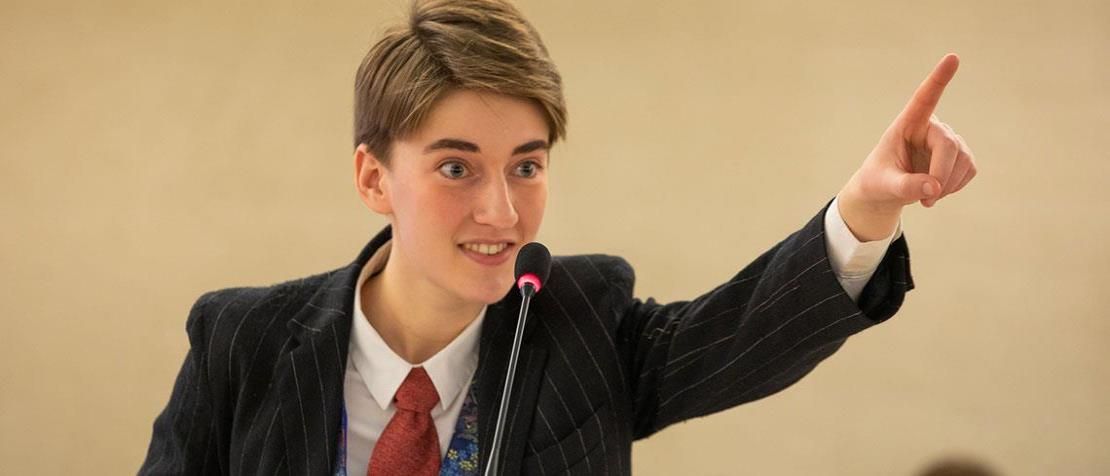
Creating ‘Futurecasters’: Here’s how we’re engaging youth on ICT policy
*The following article is adapted from my remarks today at the 25th Meeting of the Telecommunication Development Advisory Group (TDAG).
Just before the COVID-19 crisis changed the face of international cooperation, perhaps forever, the ITU Futurecasters Global Young Visionaries Summit – FerMUN 2020 was hosted by ITU in Geneva from 8-10 January.
A month before the wave of border closures and lockdown measures began, the 11 committees of the Futurecasters Youth Summit tackled 19 issues and produced 32 bold, creative, forward-thinking resolutions firmly based in the realities, challenges, and resources of the twenty-first century. These resolutions have been compiled into a report available on the ITU Futurecasters web page.
Nobody could have foreseen, then, what is happening now. Nevertheless, over the 3 days of debate in early January, the 700 high school students who participated in the Summit fulfilled our mission as Futurecasters with passion and urgency, and tackled many of the same issues governments are facing today.
The members of the health committee, for instance, discussed the subtleties of maintaining privacy, autonomy, and quality of care while adapting digital technologies for health. In today’s context, as movement surveillance and contact tracing have become suddenly widespread, this committee’s resolutions are all the more relevant.
The education committee stressed the importance of making e-learning as widely accessible as possible, while protecting children and youth from new digital dangers. These are crucial messages for us in this time of crisis, as the temporary closure of schools has disrupted learning for more than 90 per cent of students worldwide, around 1.6 billion children and young people, especially the most vulnerable and marginalised.
In each committee, in every resolution, a common call to action was heard. Participants urged member States to break down access barriers to fundamental rights, and adopt collective decision-making, transparency, and global-scale thinking. We recognized the importance of access and use of technology to promote social and economic development, and allow youth to shape the future we want.
Furthermore, when these 700 youth delegates returned home to our 50 respective schools in 23 different countries, across global regions and development categories, we carried with us the potential to become agents of change.
Developing key skills
Over the course of the conference in the ITU headquarters, we developed key skills: we learned to negotiate, collaborate, and exchange points of view; to tackle complex issues on a global scale; to solve problems, evaluate risks and obstacles, and make informed decisions. Most importantly, we were given an equal opportunity to shape debate and decision-making processes.
Now, we can bring those skills into our schools and communities; we can apply them to create solutions and change things for the better in our own spheres of influence. These innovative ideas and solutions will contribute to our communities, drive progress, and in time, inspire larger-scale decision-making.
By supporting and engaging youth in discussions on cutting-edge issues of international cooperation in collaboration with FerMUN, ITU gave us the tools to make our voices heard, and to translate those voices into real, measurable change. Instead of watching and waiting for someone else to make a decision, we learned to take initiative to create the future we want to live in.
Fundamental changes taking place
Today’s youth are struggling to find our place in the world amid massive insecurity. Fundamental changes – technological, economic and environmental – are taking place at unprecedented and ever-increasing rates. And at the same time, the instability of our societies has never been more clear than it is right now. If anxieties over rising youth unemployment and job insecurity were omnipresent before the crisis, they are now – after nearly two hundred million job losses – undeniably at the centre of our lives.
We have exactly 10 years to meet the targets of the United Nations Sustainable Development Goals. The United Nations Decade of Action calls for accelerating sustainable solutions to all the world’s biggest challenges — ranging from poverty and gender to climate change, inequality and closing the finance gap. These are years of incredible potential for us, young people. We will be choosing our paths, stepping into careers, and finding our places in the world.
This conference is an example of what we can achieve through the ITU Youth Strategy, by engaging with youth, encouraging us to participate, and empowering us to take responsibility for our future.
Reach out to today’s youth
We are calling for the international community to embrace this strategy and reach out to youth. To consult those whose futures are most at stake. To listen to the “digital natives” on how to make the most of the technological opportunities we have – and to manage unprecedented risks. This is a challenge. But it is now more urgent than ever, and we cannot afford to miss this chance.
Insecurity, risk, and crisis dominate our present. Dare to reach out to youth – and together, we will make sure engagement, participation and empowerment define our future.
